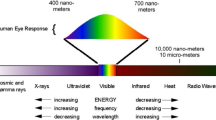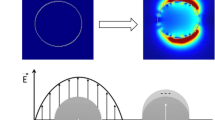Abstract
We suggest a noble design of coated and non-coated nanospheroids to study the tunable behaviour of surface plasmon resonances with different physical environments. Incorporation of coated nanospheroids into the various dielectric media exhibits double dipole plasmonic resonance spectra, which are highly tunable in the visible to infrared regions of the electromagnetic spectrum. The tunability of double dipole peaks and its spectral width depend upon the shape anisotropy of the chosen nanogeometry (especially prolate- and oblate-shaped coated silver and gold nanospheroids). By changing the major and minor axes radii of the inner ellipsoid, there is gradual blue and red shifting in the surface plasmon resonance (SPR) peak position. It was accounted that for the prolate-shaped coated gold nanospheroid with inner radii a 1 = 10 nm and c 1 = 3.8 nm and outer radii a 2 = 16 nm and c 2 = 6.08 nm, two SPR peaks are found at wavelengths 615 and 826 nm. In addition, the tunability of SPR peaks and full width at half maximum (FWHM) value have also been discussed with surrounding media and it was found that the magnitude of the peak extinction is maximum for refractive index N = 2. With the selection of various optical constants of embedding media, the wide tunability of plasmonic resonance spectra that lies in the range of 400–1100 nm has been observed. We have also discussed the advantage of coated nanospheroids over non-coated nanospheroids in the context of tunability of the SPR peak as well as the number of photons absorbed inside the thin-film wafer.








Similar content being viewed by others
References
Green MA (2004) Sol Energy 76:3
Polman A et al (2012) J Opt 14:024002
Mokkapati S, Catchpole KR (2012) J Appl Phys 112:101101
Ji A, Raziman TV, Butet J, Sharma RP, Martin OJF (2013) Opt Express 21:21500–21507
Pillai S, Catchpole KR, Trupke T, Green MA (2007) J Appl Phys 101:093105
Atwater HA, Polman A (2010) Nat Mater 9:205
Prasad PN (2012) Introduction to nanomedicine and nanobioengineering. Wiley
Aslan K, Lakowicz JR, Geddes CD (2005) Curr Opin Chem Biol Analyt Tech 9:538
Aslan K, Lakowicz JR, Geddes CD (2004) Anal Chim Acta 517:139
Thouti E, Chander N, Dutta V, Komarala VK (2013) J Opt 15:035005
Hutter E, Fendler JH (2004) Adv Mater 16:1685
Catchpole KR, Polman A (2008) Opt Express 6:21793
Pathak H, Ji A, Sharma R, Sharma RP (2015) Plasmonics. doi:10.1007/s11468-014-9865-2
Zhang Q, Large N, Nordlander P, Wang H (2014) J Phys Chem 5:370
Felidj N, Grand J, Laurent G, Aubard J, Levi G, Hohenau A, Galler N, Aussenegg FR, Krenn JR (2008) 128:094702
Palik ED (1985) Handbook of optical constants of solids. Academic, Orlando
Maier S (2007) Plasmonics: fundamentals and applications. Springer, Berlin
Cohen B, Martin C, Iyer SK, Wiesner U, Douhal A (2012) Chem Mater 24:361
Bohren CF, Huffman DR (1998) Absorption and scattering of light by small particles. Wiley, New York
Hu L, Chen X, Chen G (2008) J Comput Theor Nanosci 5:2096
Noguez C (2007) J Phys Chem C 111:3806
Pathak NK, Ji A, Sharma RP (2014) Appl Phys A 115:1445–1450
Kreibig U, Vollmer M (1995) Optical properties of metal clusters. Springer, Berlin
Hohenau A, Drezet A, Weissenbacher M, Aussenegg FR, Krenn JR (2008) Phys Rev B 78:155405
AM1.5 Spectra, American Society for Testing and http://rredc.nreal.gov/solar/spectra/am1.5/
Shockley W, Queisser H (1961) J Appl Phys 32:510
Green MA, Keevers MJ (1995) Prog Photovolt Res Appl 3:189
Gabudean AM et al (2011) Opt Mater 33:1377
Viste A et al (2010) ACS Nano 4:759
Temple TL, Bagnall DM (2013) Prog Photovolt Res Appl 21:600
Acknowledgments
This research is financially supported by MNRE India.
Author information
Authors and Affiliations
Corresponding author
Rights and permissions
About this article
Cite this article
Pathak, N.K., Pandey, G.K., Ji, A. et al. Study of Light Extinction and Surface Plasmon Resonances of Metal Nanocluster: a Comparison Between Coated and Non-coated Nanogeometry. Plasmonics 10, 1597–1606 (2015). https://doi.org/10.1007/s11468-015-9978-2
Received:
Accepted:
Published:
Issue Date:
DOI: https://doi.org/10.1007/s11468-015-9978-2




